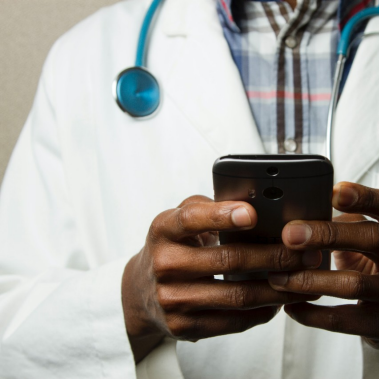This article was first published by Oliver Wyman here.
The accelerated use of digital health tools has put consumers in a virtual driver’s seat when it comes to navigating their care. They have more options than ever before to connect with providers of all kinds, even chatbots. They can generate their own health data, plug it into a variety of programs and get personalized advice on eating healthier and exercising more, not to mention being able to send real-time information to their care team. What happens on the other end of that connection is just as important. There’s enormous upside for the digitally-enabled doctor, from being better equipped to meet population health and value-based care goals to making more informed decisions. And we can’t lose sight of the fourth element of the Quadruple Aim, which is to bring joy back to practicing medicine. Ultimately, the digitally-enabled physician should have a better overall work experience leading to a lessening of fatigue and burnout. But how the technology gets deployed is critically important. And if the long, painful experience with electronic medical records and their impact on workflow taught us anything, it’s that technology can’t be viewed in isolation or as an add on; it needs to be engrained in an organization’s overarching strategy.“The way we went about it here, and that’s where we started our journey, was defining digital health as a way to be able to offer transformational care delivery that achieves the Quadruple Aim,” Aimee Quirk, Interim Senior Vice President, Digital Health at Ochsner Health, and CEO of innovationOchsner, said during a Digging Deeper session at the Oliver Wyman Health Innovation Summit.
It has become an enterprise-wide process.Aimee Quirk, Interim Senior Vice President, Digital Health, Ochsner Health
The New Orleans-based health system is zeroing in on what their digital strategy means to clinicians and other staff. “We need to support our caregivers so they can be the best supporters of patients as they come in,” Quirk said, noting that a lot of attention over the past couple of years has been paid to the consumer end of the spectrum. “It has become an enterprise-wide process.”
The IT Advantage
There’s a growing appetite for clinicians to become more digitally enabled. Nearly 90% doctors responding to a 2019 American Medical Association survey said that they see advantages to digital tools. Among primary care physicians, 40% said there was a “definite advantage,” up from 31% in 2016. The rise of telehealth during the COVID-19 pandemic also appears to be swaying doctors to using that platform more — 75% of respondents to a COVID-19 Healthcare Coalition survey said that telehealth enabled them to provide quality care in a number of areas, including chronic disease management, hospital follow-up care coordination, preventative care, and behavioral health. Additionally, 68% indicated that they’ll increase the use of telehealth in their practices.Overall, the AMA identified seven specific digital tools where physician adoption is rising:
- Remote monitoring for efficiency: Smart devices to track vital signs
- Remote monitoring and management for improved care: Apps to help with chronic disease management
- Clinical decision support: Systems integrated into the EMR that provide alerts and actionable information
- Patient engagement: Solutions that encourage patients to be more active in their wellness journey
- Telehealth, virtual visits: Audio or video tools that can increase patient interactions
- Point of care, workflow enhancement: Improved data sharing between clinicians
- Consumer access to clinical data: Providing consumers with easier access to such things as lab results, appointment reminders, and prescription refills
Overcoming Barriers
Nonetheless, there is still skepticism of expanding the use of digital tools. Many end users are still recovering from EMR deployments. Nurses and doctors complained of clunky interfaces, having to click through multiple screens to complete a task, and being bombarded with alerts. On top of that, the industry has yet figure out data exchange, although there is cautious optimism surrounding the federal government’s latest attempt at addressing interoperability through third-party apps and application programming interfaces, or APIs. Other barriers need to be overcome as well, including state licensure rules that restrict clinicians from conducting virtual visits across state lines, the lack of measurements to assess the efficacy of digital tools, and aligning reimbursement policies across all modes of care delivery. Internally, leaders need to reassure service line heads and other clinicians that while digital health tools and new care models may cause short-term pain in meeting current budget goals, it is ultimately the right thing to do for patients and the broader healthcare ecosystem.
Early Wins
Organizations need to be mindful of not repeating the same mistakes of EMR rollouts. That means improving how technology fits into a clinician’s workflow and limiting disruptions that cause them to spend more time on the computer than with a patient. Cleaning up in-basket messages is one of the first places to start. Receiving a high number of in-basket messages was associated with a 40% higher probability of burnout and 38% higher probability of reduced clinical work time, according to a 2019 Health Affairs study.
Having data illustrating how technology can make a difference in clinical care is another powerful tool to build support. Patient safety is an optimal area to look at, Suchi Saria, CEO and founder of software vendor Bayesian Health, said during a Health Innovation Summit Digging Deeper session. Beyond the moral imperative of reducing patient harm, there is a foundation of concrete measures and data to build from.
"It is hard to overemphasis that patients coming to a hospital should not be getting hurt," said Saria, who is also a professor at Johns Hopkins Whiting School of Engineering.
Utilizing digital tools to reduce medical errors and boost patient safety provides leaders with genuine success stories. Case in point: Before launching Bayesian in 2018, Saria developed an algorithm called TREWS — Targeted, Real-Time Early Warning System. It’s intended to help clinicians diagnose sepsis earlier. Between 2018 and 2020, Johns Hopkins tested the model at five hospitals. It detected 82% of patients who later were diagnosed with sepsis. Critically, 89% of doctors and nurses used the alerts generated by TREWS.
It is hard to overemphasis that patients coming to a hospital should not be getting hurt.Suchi Saria, CEO and founder of software vendor Bayesian Health
That win came from developing a platform that not only generated useful, actionable, and timely data for clinicians, but was also presented in a way that blended into their workflow, Saria said, noting that too often machine learning and other technologies are viewed solely as software and hardware. They need to be thought of in the same light as mediations and other innovations that get measured and studied for efficacy.
Similarly, workflow and physician satisfaction must be accounted for if the industry is going to maintain momentum in the use of telehealth. There are still unknowns around how to best integrate virtual care into a physician’s daily routine, for instance, what percentage of patient care can or should be virtual vs. in-person. Primary care practices offer a good model to explore, Peter Rasmussen, MD, Chief Clinical Officer of The Clinic by the Cleveland Clinic, said during a Digging Deeper session, suggesting that conducting the bulk of a wellness visit via video can create greater alignment in physician workflow and an improved consumer experience. Clinical workflows can also be aided by remote monitoring tools, he added, pointing out that having patients take their blood pressure readings in the comfort of their home with an Internet-connected device and load data directly to the EMR is likely to achieve more accurate readings than when they are sitting in a physician’s office where they are more prone to being stressed.
The Next Level
As the wins build up, organizations can push the use of digital health further and give clinicians even more tools to improve care. There are examples at work already:
- UPMC and the University of Pittsburgh School of Medicine developed a model that predicts mortality for patients who may be transferred to a higher-acuity hospital. It helps clinicians, patients and families have more detailed discussions about treatment options.
- Nemours Children’s Health built an extensive virtual platform that grew out of a successful asthma care management app. The app allowed patients and families to upload data, which is integrated into the EMR, and interact in real-time with their care team. During a pilot phase, 22% of providers used the app to inform their care decisions, Nemours executives detailed during a HIMSS21 presentation. And impressively, 100% of provider app users reported satisfaction with the platform.
- Providers aren’t the only ones pushing the envelope. Insurer Humana has been on a years-long effort to conduct social determinant of health screenings to create robust datasets aimed at improving outreach to and outcomes for members.
These types of innovations can be a catalyst in leveraging the power of digital health and put the industry on a clearer path toward addressing the Quadruple Aim. As our colleague Akshay Agarwal, MD, described during a G20 Innovation League conference in October, the potential for personalized and more streamlined care is huge if solutions are implemented in a smart and strategic way.

